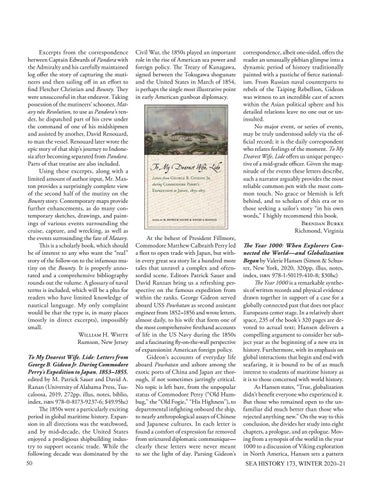Excerpts from the correspondence between Captain Edwards of Pandora with the Admiralty and his carefully maintained log offer the story of capturing the mutineers and then sailing off in an effort to find Fletcher Christian and Bounty. They were unsuccessful in that endeavor. Taking possession of the mutineers’ schooner, Matavy née Resolution, to use as Pandora’s tender, he dispatched part of his crew under the command of one of his midshipmen and assisted by another, David Renouard, to man the vessel. Renouard later wrote the epic story of that ship’s journey to Indonesia after becoming separated from Pandora. Parts of that treatise are also included. Using these excerpts, along with a limited amount of author input, Mr. Maxton provides a surprisingly complete view of the second half of the mutiny on the Bounty story. Contemporary maps provide further enhancements, as do many contemporary sketches, drawings, and paintings of various events surrounding the cruise, capture, and wrecking, as well as the events surrounding the fate of Matavy. This is a scholarly book, which should be of interest to any who want the “real” story of the follow-on to the infamous mutiny on the Bounty. It is properly annotated and a comprehensive bibliography rounds out the volume. A glossary of naval terms is included, which will be a plus for readers who have limited knowledge of nautical language. My only complaint would be that the type is, in many places (mostly in direct excerpts), impossibly small. William H. White Rumson, New Jersey To My Dearest Wife, Lide: Letters from George B. Gideon Jr. During Commodore Perry’s Expedition to Japan, 1853–1855, edited by M. Patrick Sauer and David A. Ranan (University of Alabama Press, Tuscaloosa, 2019, 272pp, illus, notes, biblio, index, isbn 978-0-8173-9237-6; $49.95hc) The 1850s were a particularly exciting period in global maritime history. Expansion in all directions was the watchword, and by mid-decade, the United States enjoyed a prodigious shipbuilding industry to support oceanic trade. While the following decade was dominated by the 50
Civil War, the 1850s played an important role in the rise of American sea power and foreign policy. The Treaty of Kanagawa, signed between the Tokugawa shogunate and the United States in March of 1854, is perhaps the single most illustrative point in early American gunboat diplomacy.
At the behest of President Fillmore, Commodore Matthew Calbraith Perry led a fleet to open trade with Japan, but within every great sea story lie a hundred more tales that unravel a complex and oftensordid scene. Editors Patrick Sauer and David Ranzan bring us a refreshing perspective on the famous expedition from within the ranks. George Gideon served aboard USS Powhatan as second assistant engineer from 1852–1856 and wrote letters, almost daily, to his wife that form one of the most comprehensive firsthand accounts of life in the US Navy during the 1850s and a fascinating fly-on-the-wall perspective of expansionist American foreign policy. Gideon’s accounts of everyday life aboard Powhatan and ashore among the exotic ports of China and Japan are thorough, if not sometimes jarringly critical. No topic is left bare, from the unpopular status of Commodore Perry (“Old Humbug,” the “Old Fogie,” “His Highness”), to departmental infighting onboard the ship, to nearly anthropological assays of Chinese and Japanese cultures. In each letter is found a comfort of expression far removed from strictured diplomatic communique— clearly these letters were never meant to see the light of day. Parsing Gideon’s
correspondence, albeit one-sided, offers the reader an unusually plebian glimpse into a dynamic period of history traditionally painted with a pastiche of fierce nationalism. From Russian naval counterparts to rebels of the Taiping Rebellion, Gideon was witness to an incredible cast of actors within the Asian political sphere and his detailed relations leave no one out or uninsulted. No major event, or series of events, may be truly understood solely via the official record; it is the daily correspondent who relates feelings of the moment. To My Dearest Wife, Lide offers us unique perspective of a mid-grade officer. Given the magnitude of the events these letters describe, such a narrator arguably provides the most reliable common pen with the most common touch. No grace or blemish is left behind, and to scholars of this era or to those seeking a sailor’s story “in his own words,” I highly recommend this book. Brendan Burke Richmond, Virginia The Year 1000: When Explorers Connected the World—and Globalization Began by Valerie Hansen (Simon & Schuster, New York, 2020, 320pp, illus, notes, index, isbn 978-1-50119-410-8; $30hc) The Year 1000 is a remarkable synthesis of written records and physical evidence drawn together in support of a case for a globally connected past that does not place Europeans center stage. In a relatively short space, 235 of the book’s 320 pages are devoted to actual text; Hansen delivers a compelling argument to consider her subject year as the beginning of a new era in history. Furthermore, with its emphasis on global interactions that begin and end with seafaring, it is bound to be of as much interest to students of maritime history as it is to those concerned with world history. As Hansen states, “True, globalization didn’t benefit everyone who experienced it. But those who remained open to the unfamiliar did much better than those who rejected anything new.” On the way to this conclusion, she divides her study into eight chapters, a prologue, and an epilogue. Moving from a synopsis of the world in the year 1000 to a discussion of Viking exploration in North America, Hansen sets a pattern SEA HISTORY 173, WINTER 2020–21
